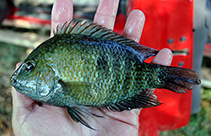| Family: |
Cichlidae (Cichlids), subfamily: Cichlasomatinae |
| Max. size: |
13.817 cm SL (male/unsexed) |
| Environment: |
benthopelagic; freshwater |
| Distribution: |
Central America: Tuxpan/Pantepec, Cazones, Tecolutla, Tenixtepec and Solteros river systems in Mexico. |
| Diagnosis: |
Dorsal spines (total): 15-17; Dorsal soft rays (total): 10-12; Anal spines: 4-6; Anal soft rays: 8-10. Herichthys tepehua is distinguished from H. deppii by having longer head (mean 37% SL, SD 2% SL vs. mean 35% SL, SD 1% SL), shorter distance from the anal fin origin to the hypural base (mean 39% SL, SD 2% SL vs. 42% SL , SD 1% SL), a larger eye (mean 26% HL, SD 3% vs. mean 24% HL, SD 2% HL). It can be diagnosed from H. carpintis in that it has a longer anal fin origin-hypural base distance (mean 39%, SD 2% vs. mean 38%, SD 2%) in SL; deeper cheeks (mean 32%, SD 4% vs. mean 28%, SD 4%) and longer snout (mean 39%, SD 4% vs. mean 37%, SD 3%) all in HL. It also differs from other congeners by the following autapomorphies: 2 conspicuous blue/ green parallel markings on the sides of the cheeks extending from the lip fold to the orbit of the eye. Ground color is blue-green. It shares with H. deppii the absence of iridescent spots/pearls on the body (Ref. 99935). |
| Biology: |
|
| IUCN Red List Status: |
Not Evaluated (N.E.) Ref. (130435)
|
| Threat to humans: |
harmless |
Source and more info: www.fishbase.org. For personal, classroom, and other internal use only. Not for publication.

